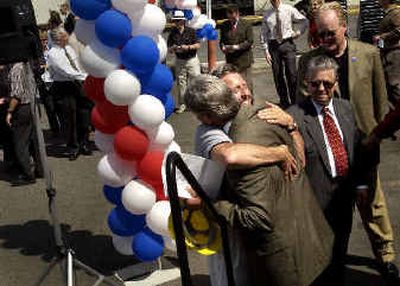Fueling economic growth

TACOMA — The building is still a tangle of extension cords, stacks of plywood, spools of wire and, everywhere, the smell of concrete dust and sheetrock. But to David Bobo, these empty, echoing rooms are an engine of economic growth just waiting to be fired up. Tacoma is nearing completion of its new Greater Tacoma Convention and Trade Center, a $122 million building rising downtown. It overlooks some of the great Northwest landmarks, from Mount Rainier to the city’s domed Union Station. Old-growth timbers, salvaged from buildings razed to make room for the center, will hang from the ceiling as a reminder of the city’s industrial roots. Tacoma is one of nearly a dozen Washington cities that are using public money to build or expand convention and meeting facilities. Spokane broke ground on its $55 million convention center expansion Thursday; Vancouver started at $71 million hotel and conference center this winter, and the Tri-Cities opened a 75,000-square-foot convention center last week. All told, more than 650,000 square feet of space for meetings, receptions, trade shows, conferences and exhibitions is being added across Washington. “There’s quite a slew of them,” said Peter McMillin, a tourism development official with the state Department of Community, Trade and Economic Development. Public money for the convention centers typically comes from a local hotel tax, a state rebate of some sales tax, and in some cases, a share of the increased property taxes spawned by growth around the new project. Tax money subsidizes the convention centers, and the number of full-time jobs is usually small, but the real power of convention centers, proponents say, is the business they spark. Visitors rent hotel rooms, rent cars, eat at local restaurants, visit museums and shop. “This is bringing in outside money,” said Bobo. “You’re not breaking even on the building itself, but you’re creating economic activity on the outside.” Some of the cities are also hoping that the centers will spur a wave of private development, as people build additional restaurants, hotels and shops. In Tacoma, a new 152-room Courtyard by Marriott Hotel is being built now, right across the street from the new center. But how much meeting space is enough — or even too much? McMillin said his agency, the economic development arm of state government, hasn’t studied the issue. “Only time will tell,” he said. Convention officials themselves are split on the matter. “I think this country has reached saturation for convention centers some time ago,” said Bobo. “Every small city that gets in trouble, they say ‘This is our answer. Let’s build a convention center.’ It’s very competitive.” The ones that succeed, he said, will be venues that can merge nearby amenities —brewpubs, museums, scenery, day-trips, and plenty of hotel rooms — with great service. John Sellers, executive director of the Tri-Cities’ new Three Rivers Convention Center, agreed. “Yes, there are a lot of facilities being constructed,” he said. “Those that are successful will be those that rise to the top in terms of providing services and quality.” In Lynnwood, where the steel beams for a new 55,000-square-foot center went up two weeks ago, executive director of the convention center, Grant Dull said he’s counting on location to be a selling point. “It’s a 20-minute drive to Seattle, 10 minutes to Everett, less than 10 minutes to Bellevue,” he said. “So anyone who wants to get out of town doesn’t have to drive far — like Spokane, for instance.” But Dull, who used to organize expositions and garden shows for a living, said he thinks there’s still plenty of demand. “I’m acutely aware that there’s a shortage of meeting space in the Northwest,” he said. It’s particularly hard for smaller groups and trade shows, he added. For one thing, he said, they rarely plan years in advance, like big groups do. Competition’s less of a worry in Spokane, said Kevin Twohig, executive director of the Spokane Public Facilities District. “If I was a betting man, I’d say that we’re not going to be very affected by that,” he said. For one thing, he said, experience counts. “We’ve been in this business for 30 years,” he said. And once the expansion’s finished, in June 2007, he said, Spokane will again have the second-largest convention center in the state, after Seattle’s. “If you need 100,000 square feet, it’s a long ways to the next 100,000-square-foot building,” he said.